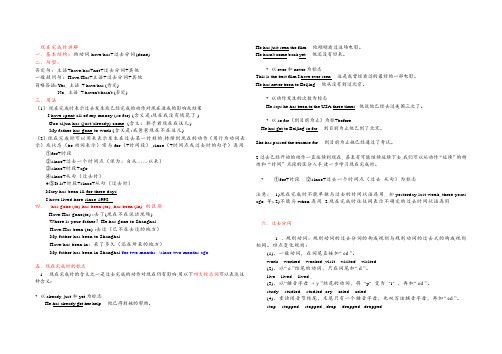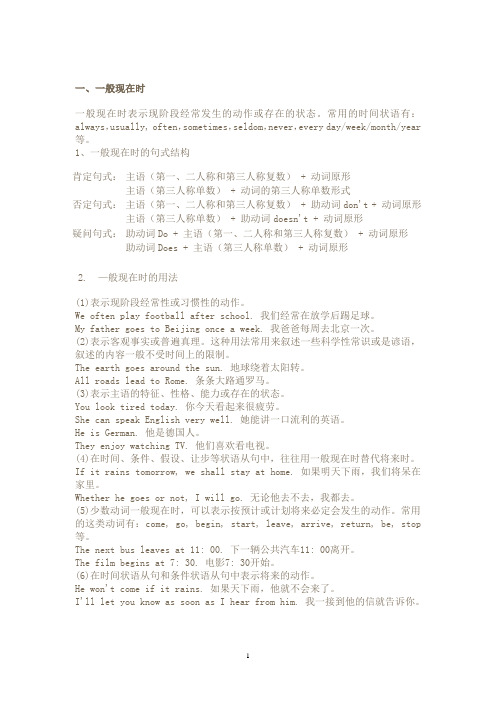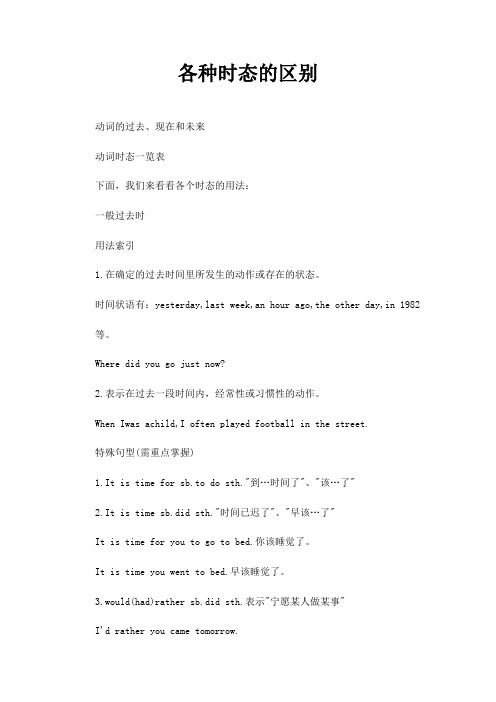现在将来时与过去将来时的用法
过去将来时的用法

过去将来时的用法1. 过去将来时的定义主要用于表示过去某个时候看来即将发生的动作或存在的状态(尤其用于宾语从句中)。
如:如: He told us he would help us. 他告诉我们他会帮助我们。
He said he would come here next Friday. 他说他下周星期五来这儿。
I knew you would agree. 我当时就知道你会同意的。
【注】在一定的语境中也可于其他从句或句子中。
如:It was a problem whether they would support us. 他们是否会支持我们还是一个问题。
It was six o’clock. The sun would soon set. 这时是六点钟。
太阳即将落山。
2. 过去将来时的结构肯定句:主语+be(was,were)going to+动词原形+其他否定句:主语+be(was,were)not going to+动词原形~.疑问句:Be(Was,Were)+主语+going to+动词原形~?肯定句:主语+would(should)+动词原形~.否定句:主语+would(should)not+动词原形~.疑问句:Would(Should)+主语+动词原形~?(1) would + 动词原形。
如:She told us that she would try her best to catch up with other classmates this term. 她告诉我们说她将一切努力在本期赶上其他同学们。
(2) 用was (were) going to + 动词原形。
表示过去某时准备做某事。
如:I was going to leave when he came in. 他进来时我正要离开。
He told us that he was going to attend the meeting. 他告诉我说他要参加那次会议。
2024新高考英语法语复习(谓语动态的时态)

3)表示客观事实、普遍真理或格言等。 例句 Light travels faster than sound. 光比声音传播得快。 Magellan proved that the earth is round. 麦哲伦证实地球是圆的。 4)表示将来。 ①在时间状语从句、条件状语从句或让步状语从句中。 例句 Even if we achieve great success in our studies, we will not be conceited. 即使我们在学习上取得很大成功,我们也不会自大的。(让步状语从句)
温馨提示 常与一般现在时连用的状语有often, always, usually, sometimes, every day, occasionally, never, seldom, generally, rarely, once a week, at weekends, on Sundays等。 2)表示现在的特征、能力、性格等。 例句 This job calls for great patience. 这份工作需要极大的耐心。 We are very busy these days. 这些天我们很忙。
—
过去将来 should/would work —
—
—
二、一般现在时 1.一般现在时的构成 一般现在时主要由动词的原形表示,如果主语为第三人称单数,则一般在 动词原形后加-s或-es,其变化规则如下表所示:
情况
一般情况
以s,sh,ch,x, o结尾的动词
以辅音字母加y 结尾的动词
规则 加-s 加-es
It was a dark night. The wind was blowing hard and the rain was falling heavily. A young woman suddenly appeared on the riverside.那是一个漆黑 的夜晚,狂风大作,大雨倾盆,一位年轻的女士突然出现在河岸上。 3)表达褒贬等感情色彩:过去进行时可以和always,constantly,continually, forever等连用,表示说话人的主观感情,如赞扬、不满、厌烦等。 例句 He was forever complaining about something. 他老是怨这怨那。
现在、过去完成时、过去将来完成讲解及练习

现在完成时讲解一.基本结构:助动词have/has+过去分词(done)二.句型:否定句:主语+have/has+not+过去分词+其他.一般疑问句:Have/Has+主语+过去分词+其他.简略答语: Yes, 主语+ have/has.(肯定)No, 主语+ haven't/hasn't.(否定)三.用法(1)现在完成时表示过去发生或已经完成的动作对现在造成的影响或结果I have spent all of my money (so far).(含义是:现在我没有钱花了.)Guo zijun has (just/already) come. (含义:郭子君现在在这儿)My father has gone to work.(含义是:我爸爸现在不在这儿)(2)现在完成时可以用来表示发生在过去某一时刻的,持续到现在的动作(用行为动词表示)或状态(be动词表示)常与for(+时间段),since(+时间点或过去时的句子)连用.①for+时段②since+过去一个时间点(译为:自从……以来)③since+时段+ago④since+从句(过去时)●⑤It is+时段+since+从句(过去时)Mary has been ill for three days.I have lived here since 1998.四.has gone (to),has been (to), has been (in) 的区别Have/Has gone(to) :去了(现在不在说话现场)Where is your father?He has gone to Shanghai.Have/Has been (to) :去过(已不在去过的地方)My father has been to Shanghai.Have/has been in:呆了多久(还在所呆的地方)My father has been in Shanghai for two months. /since two months ago.五.现在完成时的标志1.现在完成时的含义之一是过去完成的动作对现在仍有影响,用以下四大标志词可以表达这种含义:* 以already, just和yet为标志He has already got her help.他已得到她的帮助。
英语八大时态总结表时态结构与用法

英语八大时态总结表时态结构与用法八大时态是指一般现在时、一般过去时、一般将来时、现在进行时、过去进行时、过去完成时、现在完成时和过去将来时。
英语时态分为16种:一般现在、一般过去、一般将来、过去将来时,以及这四者的进行时、完成时和完成进行时下面就英语中常见的八种基本时态进行阐述,其它的时态都是在这八种时态的基础上结合而成的。
一、一般现在时:1.概念:经常、反复发生的动作或行为及现在的某种状况。
2.时间状语: always, usually, often, sometimes, every week day, year, month…, once a week, on Sundays,3.基本结构:动词原形(如主语为第三人称单数,动词上要改为第三人称单数形式)4.否定形式:am/is/are+not;此时态的谓语动词若为行为动词,则在其前加don't,如主语为第三人称单数,则用doesn't,同时还原行为动词。
5.一般疑问句:把be动词放于句首;用助动词do提问,如主语为第三人称单数,则用does,同时,还原行为动词。
6.例句:. It seldom snows here.He is always ready to help others.Action speaks louder than words.二、一般过去时:1.概念:过去某个时间里发生的动作或状态;过去习惯性、经常性的动作、行为。
2.时间状语:ago, yesterday, the day before yesterday, last week,lastyear, night, month…, in 1989, just now, at the age of 5, one day, long long ago, once upon a time, etc.3.基本结构:be动词;行为动词的过去式4.否定形式:was/were+not;在行为动词前加didn't,同时还原行为动词。
学习笔记——英语语法的八大时态

英语语法的八大时态学习笔记一般现在时一般现在时是英语语法中的一个重要部分,它用来描述经常发生的动作、习惯、事实等。
需要掌握一般现在时的用法和构成规则,以便能够正确地运用这一时态。
一、一般现在时的构成一般现在时的构成非常简单,只需要在动词原形后面加上-s或-es。
对于大多数动词来说,加-s就可以了。
例如:work →worksplay →playswatch →watches但是还有一些特殊变化的动词,需要按照它们的规则来变化。
这些变化包括:以s, x, ch, sh结尾的动词加-es。
例如:pass →passesfix →fixeswash →washesbrush →brushes以辅音字母+y结尾的动词,变y为i再加-es。
例如:study →studiescarry →carriesfly →flies有些动词是不规则变化的,需要记忆它们的变化形式。
例如:have →hasdo →doesgo →goes二、一般现在时的用法一般现在时用来描述经常发生的动作、习惯、事实等。
具体来说,它可以表示以下几种情况:经常性动作或状态。
例如:I usually get up at six o'clock.(我通常六点起床。
)She always eats breakfast before she goes to work.(她上班前总是吃早餐。
)They never go to bed late on weekdays.(工作日他们从不晚睡。
)习惯性动作。
例如:He smokes a lot.(他抽烟很凶。
)She drinks coffee every morning.(她每天早上喝咖啡。
)They often take a walk after dinner.(他们经常晚饭后散步。
)客观事实或普遍真理。
例如:The earth revolves around the sun.(地球绕着太阳转。
现在·将来·过去·进行时态

动词的时态一般现在时一般现在时v. /v.s am /is /are + Vp.p 一般过去时一般过去时v-ed was / were + Vp.p 一般将来时一般将来时will + v. will be + Vp.p 过去将来时过去将来时would + v. would be + Vp.p 过去完成时过去完成时had + Vp.p had been + Vp.p 现在完成时现在完成时have /has + Vp.p have /has been + Vp.p 将来完成时将来完成时 will have + Vp.p will have been + Vp.p 现在进行时现在进行时 am /is / are Ving am /is /are + being + Vp.p 过去进行时过去进行时 was /were + Ving was /were + being + Vp.p 一、一般现在时一般现在时表示经常发生的动作(习惯性的动作)或存在的状态,等句中常用always, usually, often, sometimes, seldom, never, every day时间状语。
时间状语。
1 一般现在时的用法一般现在时的用法1)经常性或习惯性的动作经常性或习惯性的动作I ______ ping-pong quite well, but I haven’t had time to play since the new year. A .will play B. have played C. played D. play 2)客观真理,客观存在,科学事实或表示格言或警句。
客观真理,客观存在,科学事实或表示格言或警句。
① Knowledge begins with practice. ② She said that the sea water is salty. 3)按火车、汽车、飞机等时刻表将要发生的事。
八种时态的具体用法

八种时态的具体用法:八种时态的具体用法:一般现在时表示现阶段经常或习惯发生的动作或存在的状态,或说明主语的特征。
① 一般现在时句子中常有的时间状语:often,usually,sometimes,always,every (day等), once/twice,a (week等), on (Sunday等),never,in the (morning等)。
如:They go to the Palace Museum once a year.(他们每年去一次故宫)/ They often discuss business in the evening.(他们经常在晚上商谈生意)② 表示客观真理、事实、人的技能或现在的状态时句子里一般不用时间状语。
如:The earth turns round the sun.(地球绕着太阳转)/ Light travels faster than sound.(光传播比声音快)③ 表示十分确定会发生(如安排好的事情)或按照时间表进行的事情,用一般现在可以表达将来,句子中可以有将来时间。
如:The train for Haikou leaves at 8:00 in the morning.(开往汉口的列车上午8点开车)④ 在时间状语从句中(以when, after, before, while, until, as soon as等引导)和条件状语从句中(以if,unless引导),用一般现在时代替一般将来时,句子可以有将来时间。
如:Please ring me up as soon as you arrive in Germany.(你一到德国就给我打电话) / If it rains tomorrow,we will have to stay at home.(如果明天下雨我们就只好呆在家)⑤ 一般现在时用于倒装句中可以表示正在发生的动作,动词以come, go为主。
初中英语句子的时态

一、一般现在时一般现在时表示现阶段经常发生的动作或存在的状态。
常用的时间状语有:always,usually, often,sometimes,seldom,never,every day/week/month/year 等。
1、一般现在时的句式结构肯定句式:主语(第一、二人称和第三人称复数) + 动词原形主语(第三人称单数) + 动词的第三人称单数形式否定句式:主语(第一、二人称和第三人称复数) + 助动词don't + 动词原形主语(第三人称单数) + 助动词doesn't + 动词原形疑问句式:助动词Do + 主语(第一、二人称和第三人称复数) + 动词原形助动词Does + 主语(第三人称单数) + 动词原形2. —般现在时的用法(1)表示现阶段经常性或习惯性的动作。
We often play football after school. 我们经常在放学后踢足球。
My father goes to Beijing once a week. 我爸爸每周去北京一次。
(2)表示客观事实或普遍真理。
这种用法常用来叙述一些科学性常识或是谚语,叙述的内容一般不受时间上的限制。
The earth goes around the sun. 地球绕着太阳转。
All roads lead to Rome. 条条大路通罗马。
(3)表示主语的特征、性格、能力或存在的状态。
You look tired today. 你今天看起来很疲劳。
She can speak English very well. 她能讲一口流利的英语。
He is German. 他是德国人。
They enjoy watching TV. 他们喜欢看电视。
(4)在时间、条件、假设、让步等状语从句中,往往用一般现在时替代将来时。
If it rains tomorrow, we shall stay at home. 如果明天下雨,我们将呆在家里。
英语时态总结(现在、过去、将来)

一、英语时态总结(一)现在时态(Tense)是表示行为、动作和状态在各种时间条件下的动词形式。
因此,当我们说时态结构的时候,指的是相应时态下的动词形式。
英语时态分为16种:一般现在、一般过去、一般将来、过去将来时,以及这四者的进行时、完成时和完成进行时。
在这里,我们重点讲解一下最常见的11种时态的用法和注意事项。
1. 一般现在时:A) 表示现在发生的动作、情况、状态和特征。
eg: It is a nice day.今天天气很好(表现在存在的状态)B) 习惯用语:这个要在平时自己积累,因为习语太多,不做过多解释。
eg: Believe it or not, we won the game.我们赢得了比赛,信不信由你。
口语中常说believe it or not,意思是:“信不信由你”“我说的是真的”。
believe it or not是一个固定说法,相当一个插入语,短语中的believe没有词形变化。
C) 经常性、习惯性动作。
eg: He always helps others. (他总是帮助别人。
)D) 客观事实和普遍真理。
尤其要注意,如果前后文不是一般现在时,则无法保持主句、从句时态一致.eg: He said that the sun rises in the east.他说过太阳从东方升起这个句子要注意,前边虽然said是过去式,但是后边“太阳从东方升起”是个客观真理,故不需同前边一样用过去式,而用一般现在时。
总而言之,记住:客观事实无论谓语的时态是什么都用一般现在时。
E) 表示一个按规定、计划或安排要发生的动作,(仅限于某些表示“来、去、动、停、开始、结束、继续”等的动词)可以与表示未来时间的状语搭配使用。
常见的用法是:飞机、火车、轮船、汽车等定期定点运行的交通方式。
eg: When does the plane leave?飞机什么时候起飞eg: The plane leaves at 3 o’clock this afternoon.飞机将在今下午三点起飞这个句子注意一下,飞机起飞本来是将来时,但为什么不用将来时,因为这里表示一个按规定、计划或安排要发生的动作,飞机起飞时间是规定、计划好了的。
高三英语八个基本时态的特殊用法

六、过去将来时
过去将来时表示从过去某一时刻看来将要 发生过的去动将作来或时存表在示的现状态在。或多将用来于在宾虚语拟从语句气中中。, 用过I w去as将n’来t s时ur表e w示h现eth在er或h将e w来ou的ld动d作o i。t.
If you were me, what would you do?
五、一般将来时
的生 经动W常的一作i或动般ll一。的反作将般否复或来将定发存时来形生在有时式的的时表表动状可示作示态以“。将,表不来示也能某一可”个种以、时倾表“间向示没要或将法习发来”惯。性 MThaeHncewawrilliwldloibnee.’(t1s8人tanr总etx.(是t y这要ea辆死r. 车的开。不)动。) TOhiliWnagnesdwwwiillalltcheoarmpwpeieltlnonasogeteamiyniosxut.(oeuv油rerw和yisS水hu.没nd法ay混.
We are removing into the country next week.
四、过去进行时
过去进行时表示过去或过去即将发生的 动过作去进。行时表示过去某一时刻或某一段时间
正 12..过过在去去进进进行行行的时时动代表作替示。一过般去过即去将时发,生表的示动批作评。、 赞T扬he、b厌oy烦w、as不dr满aw等in情g 绪a h。orse when I came in.I was meeting him in the town the next daSyh. e was always working like that
IIshhaavlleng’ot sweietnh hyiomu tahsesseoodnayass. I have had my bath.
英语动词时态

2015-6-5
时态的“类”
英语的四种“时”和四种“态”构成了十六种时态。
一般 进行 完成 完成进行 have/has been doing 现在完成进行时
现在
do/does 一般现在时
am/is/are doing 现在进行时
have/has done 现在完成时
过去
did 一般过去时 will do 一般将来时 would do
2015-6-5
现在进行时
现在进行时的构成 肯定形式:am/ is /are +doing 否定形式:am/is/are not +doing 疑问形式:am/is/are +主语+doing
I am doing my homework now. I am not doing my homework now. Are you doing your homework now?
2015-6-5
一般过去将来时
一般过去将来时的用法 1.表示过去的将来在某一时间发生的动作或状态,常用语间接引语中。 I was twenty-three years old now,and I would be thwety-four the next year. I didn't think they would have any objection to it. I know he would come the next day. Hebe told me that the play wouldn't act. Whenever he had time , he would come to see his parents. 2.用于虚拟语气中。 If I had money, I would buy a car. It is necessary that we should invite him.
动词时态过去将来时的用法

动词时态过去将来时的用法动词时态是语法中非常重要的一个部分,它能够帮助我们准确地表达不同时间点的动作或状态。
除了一般现在时、一般过去时、一般将来时等常用时态之外,我们还需要了解并正确运用过去将来时。
本文将详细介绍过去将来时的用法及相关例句,帮助读者更好地理解和掌握这一时态。
一、过去将来时的基本情况过去将来时是指在过去某一时间点,我们对未来某个时间点的动作或状态进行描述。
它使用了过去的形式来表示将来的时间。
常用的过去将来时表达方式有以下两种:1. would/could/should/might + 动词原形这种形式常用于表示愿望、打算、预测、建议等意义。
2. was/were going to + 动词原形这种形式常用于表示过去计划、决定或意图要做某事的情况。
二、过去将来时的具体用法1. 表示过去的打算或意图过去将来时可以用来表示过去某个时间点的打算或意图,但这个打算或意图并没有实现。
例如:She said she would visit her grandparents last weekend.(她说她上周末会去看望她的祖父母。
)2. 表示过去的预测或推测过去将来时还可以用来表示过去某个时间点的预测或推测。
例如:The teacher thought the students would pass the exam.(老师认为学生们会通过考试。
)3. 表示过去的建议或请求过去将来时也可以用来表示过去某个时间点的建议或请求。
例如:He hoped his friend would help him with the project.(他希望他的朋友能帮他完成这个项目。
)4. 表示过去的条件语句过去将来时还常常用来表示过去的条件语句。
例如:If he had more time, he would travel around the world.(如果他有更多时间,他会周游世界。
)5. 表示过去的客观情况过去将来时还可以用来表示过去某个时间点的客观情况,而非个人打算、预测或请求。
四种将来时态的用法归纳

四种将来时态的用法归纳-标准化文件发布号:(9556-EUATWK-MWUB-WUNN-INNUL-DDQTY-KII四种将来时态的用法归纳一般将来时1.基本用法及表示方法。
一般将来时的基本用法是表示单纯的将来事实,由“will / shall + 动词原形”构成。
如 We shall have a lot of rain next month. 下个月将下很多雨。
I think she will pass the exam. 我想他考试会及格的。
2.表示将来时间的几种常见方法。
英语中除了“will /shall+动词原形”表示半来时态外,还可以有以下多种方法。
如:转自环球网校(1) 用“be going to+动词原形”表示。
主要表示打算和预测。
如:We are not going to stay there long. 我们不准备在那里多待。
(表打算)I’m afraid they’re going to lose the game. 恐怕他们会赛输。
(表预测)Look, it’s going to rain. 瞧,要下雨了。
(表预见)注:be going to 后接动词go和come时,通常直接改用其进行时态。
如:Where is he going to go / Where is he going 他打算到哪里去(2) 用“be to+动词原形”表示。
主要表示按计划或安排即将要发生的动作;有时也表示命令、禁止或可能性。
如:He is to leave for Beijing tomorrow. 他决定明天去北京。
Tell him he’s not to be back late. 告诉他不准迟回。
(3) 用“be about to+动词原形”表示。
主要表示即将要发生的事。
如:He is about to leave. 他即将要离开。
Sit down, everyone. The film is about to start. 大家坐好,电影马上就要开发始了。
现在时﹑过去时﹑将来时﹑过去将来时

一般过去时一般过去时:简单地说是表示过去发生的动作或存在的状态。
我们首先来看看一般现在时的构成。
一般现在时的构成:a. be动词过去式的句式。
否定句是在was/were后面加not,was not (wasn't)/were not (weren't)。
一般疑问句是把was / were提前并放到句首,要求首字母要大写。
b.实义动词过去式的句式。
①肯定式:主语+动词过去式+其它。
如:They had a good time yesterday.②否定式:主语+did not(didn't)+动词原形+其它。
如:They didn't watch TV last night.③一般疑问句:Did+主语+动词原形+其它?肯定回答:Yes,主语+did.否定回答:No,主语+didn't.如:Did they have a meeting two days ago? Yes,they did. / No,they didn't.④特殊疑问句:特殊疑问词+did+主语+动词原形+其它?如:What time did you finish your homework?知道了一般现在时的构成,我们在看看在什么情况下,我们才能使用它。
一般过去时的用法:①一般过去时的基本用法a)表示过去某个特定时间发生的动作或存在的状态。
He suddenly fell ill yesterday.昨天他突然生病了。
The engine stopped because the fuel was used up.发动机因燃料用光而停机了。
b)表示过去经常发生的动作或存在的状态。
I wrote home once a week at college.我上大学时每周给家里写一封信。
He was already in the habit of reading widely in his boyhood.他童年时就养成了广泛阅读的习惯。
将来时态的使用方法

5、 be going to+不定式
“be going to+不定式”的另一意义是表达说话人对可能性的预见,即现在已经有迹象表 明将要发生或即将发生某种情况。例如: ① A: The ceiling in this room doesn't look very safe, does it? B: No, it looks as if it is going to fall down. ② I feel terrible. I think I'm going to be sick. “will+不定式”和“be goingto+不定式”在表达“预见”时的区别主要在于:be going to结构暗示 有迹象表明某事件即将发生,而will 结构则表示作者认为或相信某事即将发生。
6、 现在进行体
现在进行体表示根据计划或安排将要发生的动作。当动词为go,come,leave, start, arrive,visit 等时,我们通常用现在进行体而不用be going to 结构。例如: They are going to Madrid(马德里) next Sunday. Mary is leaving the day after tomorrow. Ian isn't playing football on Saturday. He's hurt his leg. I'm not working tomorrow, so we can go out somewhere.
B: Yes, I know. I _______ (clean) them later. (5) I’ve decided not to stay here any longer. Tomorrow I ______ (look) for somewhere else to stay. (6) Don’t worry about your exam. I’m sure you _____ (pass).
过去将来时的用法如何使用过去将来时

过去将来时的用法如何使用过去将来时一般过去将来时表示从过去的某一时间来看将来要发生的动作或呈现的状态。
那么你对过去将来时的使用方法了解多少呢?以下是由店铺整理关于过去将来时的用法的内容,希望大家喜欢!过去将来时的用法一、"would+动词原形"表示过去将来时"would+动词原形"构成过去将来时,常表示根据计划或安排即将发生的事。
例1:He said he would come to see me.他说他要来看我。
例2:He told me he would go to Beijing.他告诉我他将去北京。
二、"was /were+going to+动词原形"表示过去将来时"was /were+going to+动词原形"也可表示根据计划或安排即将发生的事。
例1:She said she was going to start at once.她说她将立即出发。
例2:I was told that he was going to return home.他告诉我他准备要回家。
"was /were+going to+动词原形"还可表示根据当时情况判断有可能但不一定会发生某事。
例:It seemed as if it was going to rain.看来好像要下雨。
三、某些动词的过去进行时可表示过去将来时come,go,leave,arrive,start等严格按照时间表发生的表起止的动词可用过去进行时代替过去将来时。
例1:He said the train was leaving at six the next morning.他说火车第二天早晨出发。
例2:She told me she was coming to see me.她告诉我她要来看我。
四、特定场合的一般过去时可表示过去将来时条件状语从句和时间状语从句中须用一般过去时代替过去将来时。
各种时态的区别

各种时态的区别动词的过去、现在和未来动词时态一览表下面,我们来看看各个时态的用法:一般过去时用法索引1.在确定的过去时间里所发生的动作或存在的状态。
时间状语有:yesterday,last week,an hour ago,the other day,in 1982 等。
Where did you go just now?2.表示在过去一段时间内,经常性或习惯性的动作。
When Iwas achild,I often played football in the street.特殊句型(需重点掌握)1.It is time for sb.to do sth."到…时间了"、"该…了"2.It is time sb.did sth."时间已迟了"、"早该…了"It is time for you to go to bed.你该睡觉了。
It is time you went to bed.早该睡觉了。
3.would(had)rather sb.did sth.表示"宁愿某人做某事"I'd rather you came tomorrow.请你注意:一般过去时的时间状语应该是表示过去某个时间的词或词组,如:yesterday,last month,in 1999,two days ago等,绝对不可与recently,in the past 10 years,this month等连用,因为这样的时间状语都与现在有关系,应该用现在完成时或一般现在时。
过去进行时用法索引1.表示过去某个时刻或某一阶段正在进行的动作.构成:be(was,were)+现在分词,常用的时间状语:at 10:30 last night,this time yesterday evening Eg1.What were you doing at three o'clock yesterday afternoon?2.用于when,while引导的时间状语从句中。
- 1、下载文档前请自行甄别文档内容的完整性,平台不提供额外的编辑、内容补充、找答案等附加服务。
- 2、"仅部分预览"的文档,不可在线预览部分如存在完整性等问题,可反馈申请退款(可完整预览的文档不适用该条件!)。
- 3、如文档侵犯您的权益,请联系客服反馈,我们会尽快为您处理(人工客服工作时间:9:00-18:30)。
现在将来时与过去将来时
一.表示将来时间的多种结构
1.will / shall (not) + V(原型)
“will / shall + 不定式”通常用来表示将来时间。
Will 用于第一、二、三人称主语,Shall 用于第一人称主语,都可表示将来时间,但这种将来意义常常夹杂着情态意义,即带有说话人的主观态度和看法,比如表示“预见(Prediction)”:
The next train to Beijing will leave at 8 a.m.
You will feel better after taking this medicine.
He won’t be here in time unless he comes by air.
I’m sure I shan’t lose my way in the woods.
We shall know the result next week.
2.will / shall (not) + V进行体/完成体
既然“will / shall + V(原型)”往往夹杂着情态意义,如果我们要表示“纯粹”将来,便可采用“will / shall + V(进行体)”结构。
这种结构通常带有“自然要发生”的含义,因而不包含“意愿”、“意图”等情态意义。
例如:
The train will be arriving at two o’clock.
I shall be writing to you soon.
He won’t be coming to the party this evening.
You can use my bike, I won’t be needing it tomorrow.
这种“will / shall + V(进行体)”的结构也可以表示将来某一时刻或时间段里正在进行的动作。
例如:
What will you be doing this time tomorrow morning?
I’ll be working in this company during May.
如果表示将来某一时刻之前已经完成的动作,便可用“will / shall + V(完成体)”。
例如:You will have completed the English course by this time next year.
The snow will have disappeared before the end of March.
3.be (not) going to +V(原型)
这一结构的主要意义,一是表示“意图”,即打算在将来做某事。
例如:
I’m going to post that letter by air mail.
We are going to call a meeting to discuss it.
He is going to be a doctor when he grows up.
这一结构的另一意义是表示“预见”,即现在已有迹象表明将要发生或即将发生某种情况。
Look at these black clouds一there’s going to be a storm.
I feel dizzy(眩晕). I think I’m going to faint(晕倒).
4.be + Ving(现在进行体)
这一结构的主要意义是表示按照计划、安排,即将发生的动作,常用于表示位置转移的动词,如go, come, leave, start, arrive等,也可用于其它动态动词。
例如:
We are leaving on Friday.
He is moving to a different hotel the day after tomorrow.
The president is coming to the United States this week.
The plane is taking off at 5:00 p.m.
5.be (not) to+ V(原型)
这一结构的主要用法,一是表示按计划、安排,即将发生的动作。
例如:
I am to have tea with my best friend this afternoon.
Where are we to stay tonight?
二是表示命令、禁止或可能性等。
例如:
You are to stand here. Do you understand?
Tell her she’s not to be back late.
The dictionary is not to be had here.
6.一般现在时
用一般现在时表示将来时间,常见于条件状语和时间状语分句。
例如:
If she comes, I’ll tell her all about it.
I’ll give it to you after I return.
二.过去将来时间表示法
1.would +V(原型)
用“would +V(原型)”表示过去将来时间,通常带有表示过去将来的时间状语,而且多见于从属分句。
例如:
He said he would come back the next day.
We never imagined that he would become a doctor.
用“would +V(进行体)”表示在过去将来某一时间正在进行的动作。
例如:
He told his friend that this time next year he would be studying at abroad.
He never imagined that someday he would be living away from his motherland.
用“would +V(完成体)”表示从过去某时开始一直延续到将来某时的动作或事态。
例如:She said that by the end of May she would have been studying medicine for three years.
By six o’clock that afternoon, they would have been cleaning the house for five hours.
2.was / were going to + V(原型)
用“was / were going to + V(原型)”表示过去将来.
例如:He was going to play tennis that afternoon.
He said that he was going to live in the countryside when he retired.
3.was / were to + V(原型)
用“was / were to + V(原型)”表示过去将来,通常指按过去的计划、安排,将在某个过去将来时间发生的事态。
例如:
As I was to leave the next day, I went to bed early on Thursday evening.
4.一般过去时表过去将来
常用于某些条件状语和时间状语分句。
例如:
He said he would tell her all about it if he met her.
She told me that she would come to see me when she visited China again.。
